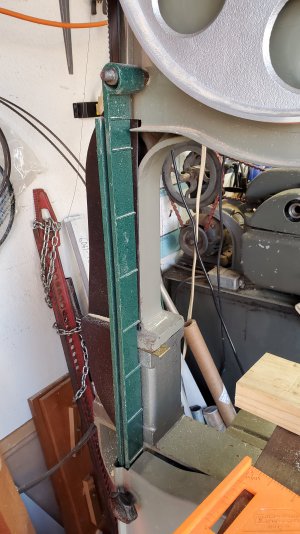- Joined
- Apr 12, 2013
- Messages
- 562
I got this as a 'gift' from an uncle. I suspect he knew it had issues and was pulling a fast oen on me. Grizzly 1019, older model 14", with riser block. Numerous issues that all look like alignment problems to me.
1) Doesn't cut straight.
2) Blade tracking is terrible, top wheel is scraping the cover (almost no more adjustment available) with blade riding the back of the wheel, the bottom is the opposide with the blade teeth hanging slightly off the front of the wheel.
3) Terribly hard to align guides, and have to realign every time the upper guide is moved to a different height.
4) Blade takes a turn immediately upon making contact with material, so straight cuts just aren't going to happen. Solid guide blocks, have adjusted them many times and can't get this out. Many different blades, mostly Powermatic, 3/8" and 1/2".
A) Many adjustment iteratoins and I can get a 2x4 cut to within 2-3 degrees of straight, but still get a bit of wave. The front of the cut is square, the end of the cut is angled top to bottom. One side of the board is cut square, the other is angling the whole way binding the blade significantly if the material is thick.
B) A pair of .032" shims under the front of the riser block angles the upper section enough to get tracking mostly aligned. At least both wheels have the blade in their center third.
C) Would love to buy bearing blade guides but not going to spend $$$ on wasted effort if this thing is not fixable.
D) Without riser block things are slightly better but not enough to be usable for anything better than cutting small limbs into firewood and roughing out stuff that doesn't need to be at all precise.
So is this a lost cause? Has this thing been dropped and 'sprung' beyond fixing? What does it sound like to y'all???
1) Doesn't cut straight.
2) Blade tracking is terrible, top wheel is scraping the cover (almost no more adjustment available) with blade riding the back of the wheel, the bottom is the opposide with the blade teeth hanging slightly off the front of the wheel.
3) Terribly hard to align guides, and have to realign every time the upper guide is moved to a different height.
4) Blade takes a turn immediately upon making contact with material, so straight cuts just aren't going to happen. Solid guide blocks, have adjusted them many times and can't get this out. Many different blades, mostly Powermatic, 3/8" and 1/2".
A) Many adjustment iteratoins and I can get a 2x4 cut to within 2-3 degrees of straight, but still get a bit of wave. The front of the cut is square, the end of the cut is angled top to bottom. One side of the board is cut square, the other is angling the whole way binding the blade significantly if the material is thick.
B) A pair of .032" shims under the front of the riser block angles the upper section enough to get tracking mostly aligned. At least both wheels have the blade in their center third.
C) Would love to buy bearing blade guides but not going to spend $$$ on wasted effort if this thing is not fixable.
D) Without riser block things are slightly better but not enough to be usable for anything better than cutting small limbs into firewood and roughing out stuff that doesn't need to be at all precise.
So is this a lost cause? Has this thing been dropped and 'sprung' beyond fixing? What does it sound like to y'all???



